Dynamics of a Transportation Network Model with Homogeneous and Heterogeneous Users
Abstract
This paper studies the dynamics of the traveler′s day-to-day route adjustment process in the general transportation network with fixed or elastic demand and homogeneous or heterogeneous users. Each traveler is assumed to adjust his/her route choice according to the excess travel cost between the instantaneous experienced travel cost and a certain referred level, which induces an aggregate path flow dynamics. We call the path flow dynamics the excess travel cost dynamics, which corresponds to the excess payoff dynamics in evolutionary games and serves a general framework of modeling the homogeneous or heterogeneous route choice behavior of travelers.
1. Introduction
Network equilibrium models have a long history, both in the transport research literature and in practical studies of scheme assessment, since the notion of user equilibrium (UE) was proposed [1]. At equilibrium, all travelers on the same origin-destination pair experience the same travel cost, while all unused routes have equal or higher travel costs. Wardrop equilibrium has been extended in different senses to address real world needs in transportation planning, analysis, and management, including stochastic user equilibrium (SUE) to allow imperfect information or user perception error in their route choice [2]; dynamic user equilibrium within-day to incorporate the departure time choice in route choice [3, 4].
To model the travelers′ response to exogenous information, the growing interest in day-to-day dynamics has received much study after the original research of Horowitz [5], in which a two-link transportation network is adopted to explain the day-to-day dynamic link and path flow patterns and the stability issue. The evolution over days of travel choices or a learning rule based on the past experience associated with the traffic assignment model are the main methodologies to capture the day-to-day behavior. A comprehensive literature review on the day-to-day dynamics is made by Bie and Lo [6]. In the literature, travelers′ day-to-day route choice adjustment behavior is modeled as either a deterministic dynamic process, such as the simplex gravity flow dynamics [7], the proportional-switch adjustment process [8, 9], the network tatonnement process [10], the projected dynamical system [11], and evolutionary traffic dynamics [12], or a stochastic dynamic process [13, 14]. Yang and Zhang [15] focused on the deterministic dynamic route adjustment process on modeling drivers dynamic route choice adjustment behavior and proved that many commonly used dynamic processes are so-called Rational Behavior Adjustment Process (RBAP) since the aggregated travel cost of the entire network decreases over days except that the path flow becomes stationary and is the user equilibrium path flow. He et al. [16] developed a link-based day-to-day dynamic traffic assignment model to copy with two essential pitfalls of the path-based model, that is, the initial path flow pattern is typically unidentifiable and different initial path flow patterns constituting the same link flow pattern generally give different day-to-day link flow evolutions; the path-based models ignore the interdependence among paths and thus can give very unreasonable results for networks with paths overlapping with each other. The day-to-day route adjustment process provides a useful tool for transportation management. Peeta and Yang [17] demonstrated that providing properly advanced travel information to the road users can result in the social optimal link flow pattern by assuming that the travelers′ day-to-day route adjustment behavior follows the proportional-switch adjustment process. Using the potential games theory, Sandholm [12] proposed an evolutionary implementation mechanism for continuous dynamic route-based pricing policy to ensure the efficient use of the roadway system, while allowing for users to follow any reasonable myopic adjustment process. Apart from the unknown demand or demand function, he assumed that the individual traveler′s day-to-day route choice adjustment process is not known to the planner either.
However, if the road pricing scheme is adopted in the transportation network as Sandholm [12], the day-to-day route adjustment process should incorporate the travelers′ heterogeneous behavior since they value the monetary and time costs in different ways. With this consideration, we assume that all travelers in the transportation network can be classified into several discrete classes, the user in each class is captured by a parameter, value-of-time (VOT) which converts the travel time cost into the equivalent monetary cost [18]. It is easy to understand that the users in different user classes adjust their route choice in different ways according to their VOT values. In this paper, we develop a general model framework to capture the travelers′ day-to-day route choice behavior, which considers the general transportation network with fixed or elastic demand, homogeneous or heterogeneous users. In this study, each traveler is assumed to adjust his/her route choice according to the excess travel cost between the instantaneous experienced travel cost and a certain referred level. The aggregate path flow dynamics induced by this model can be viewed as a natural extension of the so-called rational behavior adjustment process proposed by [15]. We call this path flow dynamics the excess travel cost dynamics, which corresponds to the excess payoff dynamics in evolutionary game [19]. The excess travel cost dynamics serves as a more general framework than the rational behavior adjustment process for modeling the travelers′ dynamic route choice behavior in the transportation network with fixed or elastic demand, homogeneous or heterogeneous users. The Lyapunov function method is commonly used to study the stability of the equilibrium solutions [8, 10]. LaSalle′s theorem addressing system stability over a set of equilibrium solutions rather than an isolated point [20] has been adopted by several researchers to study the stability of dynamic transportation network [6, 17, 21]. In this study, we use LaSalle′s theorem to study the stability of the excess travel cost dynamics.
The paper is organized as follows. Section 2 introduces the definition of the excess travel cost dynamics. The stability issue for the proposed dynamic system is addressed in Section 3. Finally, conclusions are given in Section 4.
2. Day-to-Day Dynamical Route Adjustment Process
2.1. Excess Travel Cost Dynamics with Homogeneous Users
Three assumptions on travelers′ route adjustment process are proposed and compared by Nagurney and Zhang [11]. The third one among those assumptions is suggested to be the most reasonable and defined by Yang and Zhang [15] as the rational behavior adjustment process (RBAP) with fixed demand. The day-to-day route choice adjustment process is the RBAP with fixed travel demand if the aggregated travel cost of the entire network decreases based on the previous day′s path travel costs when path flows change from day to day; otherwise, if path flow becomes stationary over day, then it is equivalent to the user equilibrium path flow. That is to say, if the current path flow pattern is not UE path flow, then . The RBAP is mild and includes various commonly used route choice adjustment process as its special cases, such as the proportional-switch adjustment process [17], the projected dynamical system [11], and the Brown-von Neumann-Nash dynamics [22].
- (A1)
dynamic system (2.3) admits a unique solution trajectory for any given initial condition, and the trajectory is Lipschitz continuous;
- (A2)
whenever F(f) ≠ 0 where the excess travel cost, , of path r ∈ Rw between w ∈ W is a well-defined function of link flow vector f;
- (A3)
f* is an equilibrium point of system (2.3) if F(f*) = 0.
With the excess travel cost dynamics, the aggregated excess travel cost of the entire network must decrease from the previous day′s path travel costs when path flows change from day to day; otherwise, if path flow becomes stationary over days, then it is equivalent to the user equilibrium path flow. Define the excess payoff for using each path as −ETC, then the excess travel cost dynamics is the excess payoff dynamics, which is a special case of the well-behaved dynamics proposed by Sandholm [19].
2.2. Excess Travel Cost Dynamics with Heterogeneous Users
The excess travel cost dynamics, described above, assumes that all travelers perceive the path travel cost identically (travel time plus a discount monetary cost). However, it is well known that travelers may value travel time differently, depending on their income levels or travel purposes. Thus, when a toll policy is introduced into the network, heterogeneous users with different value of time (VOT) have to be considered in converting travel time into equivalent monetary cost. In this subsection, we focus our discussion on the behavior assumption of the route choice adjustment process in presence of the user heterogeneity. Furthermore, we consider a discrete set of user classes corresponding to the groups of users with different socioeconomic characteristics, such as income level.
- (A2′)
whenever F(f) ≠ 0.
Assumption (A2′) says that, for any given and fixed link toll pattern, τ = {τa, a ∈ A}, each user adjusts his/her route choice according to his/her own preference, which results in the decrease in aggregated excess travel cost of the entire network in time unit in comparison with that on previous day when path flows change from day to day. A stronger behavior assumption is that the flow on those paths on which travelers experienced positive excess travel cost strictly decreases, and vice versa. Assumption (A2′) is a direct extension of the homogeneous case, in which all travelers have an identical VOT.
Example 2.1. The proportional-switch adjustment process (PSAP) was first introduced by Smith [8] to suppose that the drivers on a higher cost path switch to other lower cost paths in a rate that is proportional to the cost difference between this path and the other lower cost paths. Peeta and Yang [17] modeled the dynamical traffic flow switch rate of the PSAP with fixed demand as:
We now consider the elastic demand based on the simple model of PSAP. Suppose that there is a dummy link associated with each OD pair and the latent noncar travelers traverse from the origin to the destination by the dummy link. Suppose there is a large potential demand for each OD pair, Qw. The dummy link, , is associated with the travel cost of and flow , where qw and denote the revealed and latent demand between OD pair, w ∈ W, respectively. Namely, and . Let the average travel cost be . Like the case with fixed demand, the excess travel cost is defined as the difference between the travel cost and the average travel cost associated with the specific path. The PSAP with elastic demand can be revised, for and w ∈ W, as
3. Stability of the Excess Travel Cost Dynamics
The stability is a central issue for the dynamic system analysis. Peeta and Yang [17] investigated the system stability over a set of desirable states rather than an isolated point, applying LaSalle′s invariant set theorem for the dynamic traffic assignment problem with fixed demand by assuming the proportional-switch adjustment process, given by (2.5). The objective functions of the system optimum and user equilibrium problem are adopted as the Lyapunov functions to conduct the stability analysis, which is physically meaningful. Similar method of constructing Lyapunov function is also used by Jin [21] to examine the system stability of the dynamic traffic assignment problem under OD first-in-first-out violation situation. In this section, in a similar spirit of [17], the system stability of the excess travel cost dynamics proposed in Section 2 is addressed.
A set Π is an invariant set of dynamic system (2.3) if every system trajectory which starts from a point in Π remains in Π for all future time [20]. For instant, any equilibrium point of system (2.3) or, F(f) = 0, as a set is an invariant set. LaSalle′s invariant set theorem is stated as the follows.
Lemma 3.1 (LaSalle’s invariant set theorem [20]). Consider the autonomous system . Let V(x) be a scalar continuously differentiable function such that
- (1)
lim |x|→∞V(x) = ∞, or, function V(x) is radically unbounded;
- (2)
for all x ∈ Ω.
The standard LaSalle′s invariant set theorem described above is in general not applicable in the case of discontinuous right-hand side, such as, projected dynamic system [11] and the network tatonnement process [10]. In this case, the generalized invariant set theorem [23] is applicable, only requiring the existence, uniqueness, and continuity of the solution of dynamic system that are guaranteed by assumption (A1). In this study, the standard LaSalle′s invariant set theorem is adopted to investigate the stability issues of dynamic system (2.3).
3.1. Stability Property of the Dynamic System with Homogeneous Users
Lemma 3.2. The set Π, defined by (3.3), is an invariant set of system (2.3), namely, f(0) ∈ Π implies that f(s) ∈ Π, for all s ≥ 0.
Proof. From assumptions (A2)-(A3), we know that F(f) ≠ 0⇒ETC(f)∘F(f) < 0 and, conversely, ETC(f)∘F(f) = 0⇒F(f) = 0, which implies that f is an equilibrium point. It is clear that Π = {f ∈ Ω : ETC(f) = 0} = {f ∈ Ω : F(f) = 0} is an invariant set of system (2.3). The proof is completed.
From Lemma 3.2, we now investigate the stability of system (2.3).
Theorem 3.3. Under assumptions (A1)–(A3), any solution of system (2.3) converges to the invariant set, Π, defined by (3.3), and, thus, the dynamic path flow pattern with any initial state induces the user equilibrium link flow pattern of static traffic assignment problem.
Proof. Consider the following continuously differentiable function (we only consider the case with elastic demand):
The rational behaviour adjustment process proposed by Yang and Zhang [15] is a useful concept frame to model the rational behaviour of the travellers under which the route adjustment process must reduce the aggregate total travel cost of the whole network day by day. However, the definition is suitable only for the case with fixed demand. More generally, the excess travel cost dynamics, or, excess payoff dynamics introduced by Sandholm [19] can incorporate the cases with fixed and elastic demand. Theorem 3.3 depicts that for the excess travel cost dynamics satisfying assumptions (A1)–(A3), any dynamic path flow pattern must move to a certain UE path flow pattern, which induces the UE link flow pattern. Therefore, the set of all UE path flow patterns is a stable invariant set.
Example 3.4. Consider that the following simple network example, shown in Figure 1, consists of 4 links, 4 nodes, and 2 OD pairs. The OD pairs and the corresponding path are listed in Table 1. Each OD pair has one unit fixed demand. Since all links have the same link travel time function, ti(vi) = vi, it is clear that the user equilibrium path flow pattern is not unique although there is a unique link flow pattern.
| OD pair | Path |
|---|---|
| 1→4 | Path 1: {1,3}, f1 |
| q1→4 = 1 | Path 3: {1,4}, f3 |
| 2→4 | Path 2: {2,3}, f2 |
| q2→4 = 1 | Path 4: {2,4}, f4 |
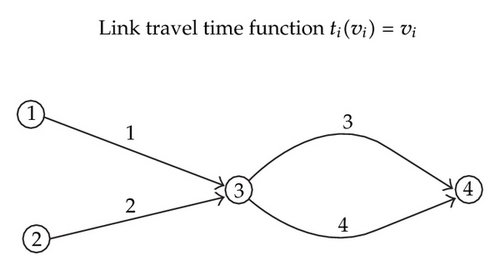
Using MATLAB Simulink, the behavior of the dynamic system (3.7) starting from 500 randomly selected initial states in the all feasible domain is shown in Figure 2. It is clear that, for the path flow dynamic system (3.7), the equilibrium states consist of a set rather than an isolated equilibrium point is an invariant set, and no equilibrium state is stable for path flow pattern in the sense of Lyapunov stability although the link flow is stable.
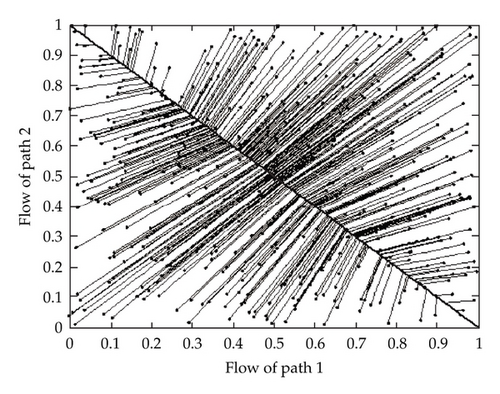
3.2. Stability Property of the Dynamic System with Heterogeneous Users
Theorem 3.5. Under assumptions (A1), (A2′), and (A3), for any given and fixed link toll pattern, any solution of system (2.3) with heterogeneous users converges to a certain user equilibrium path flow pattern, which results in the multiclass user equilibrium link flow pattern.
Although the route adjustment behavior assumption is relaxed to consider the heterogeneity of travelers, that is to say the individual traveler adjusts his/her route choice based on his/her own perception, the multiclass UE link flow pattern is obtained. Theorem 3.5 also provides a method to calculate the multiclass UE link flow pattern.
Example 3.6. Consider the network example [18], shown in Figure 3, consisting of 5 links, 4 nodes, and 2 OD pairs. The link cost functions are given by
| OD pair | Path |
|---|---|
| 1→4 | Path 1: {1} |
| q1 | Path 3: {2,3} |
| 2→4 | Path 2: {4,3} |
| q2 | Path 4: {5} |
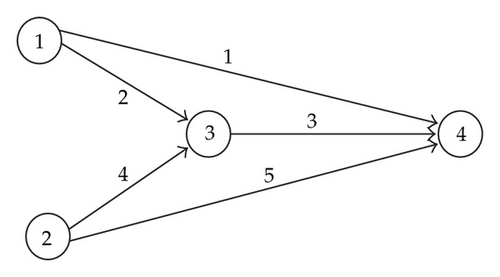
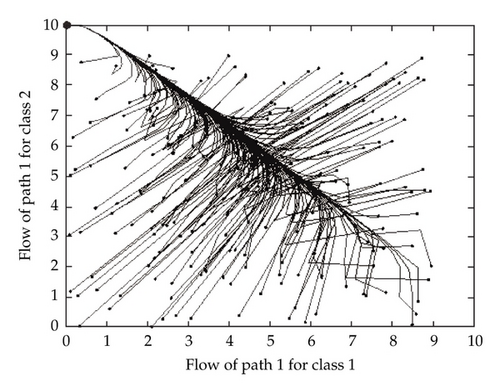
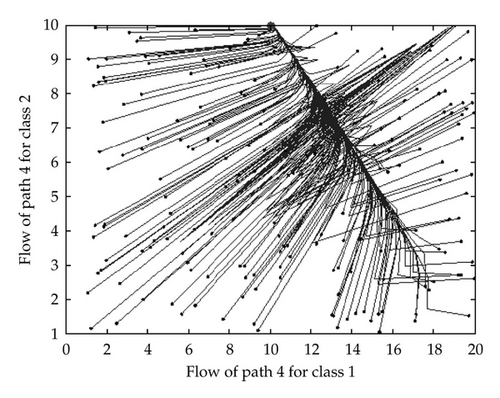
4. Conclusion
We presented an excess travel cost dynamics to model travelers′ route choice behavior in a transportation network with fixed or elastic demand and homogeneous or heterogeneous users. The excess travel cost dynamics is a natural extension of the rational behavior adjustment process proposed by Yang and Zhang [15], which corresponds to the excess payoff dynamics in evolutionary game [19]. The excess travel cost dynamics serves as a more general framework than the rational behavior adjustment process for modeling the travelers′ dynamic route choice behavior in the transportation network with fixed or elastic demand, homogeneous or heterogeneous users. LaSalle′s theorem is adopted to study the dynamic system stability. We proved that the trajectories of the excess travel cost dynamics with any initial state converge to the user equilibrium link flow pattern in various scenarios (fixed or elastic demand, homogeneous or heterogeneous users).
It is an interesting challenge to design the system optimum pricing scheme in a transportation network by taking into account both the hidden actions of travelers′ day-to-day route choice adjustment and the true but unknown demands, specially, with heterogeneous users. Another research direction is to model the heterogeneous behavior of the travelers on their perceived travel cost except the way valuing the monetary and time costs, which requires a stochastic dynamic route choice process incorporating the user heterogeneity.
Acknowledgments
The authors are very grateful to the referees for their valuable suggestions, which helped to improve the paper significantly. The work described in this paper was supported by the Research Fund for the Doctoral Program of Higher Education of China (20110142120086), the self-determined and innovative research funds of HUST (2011QN103).




